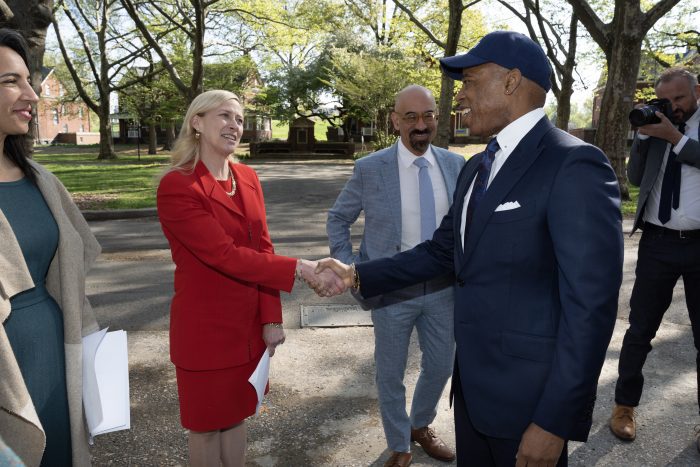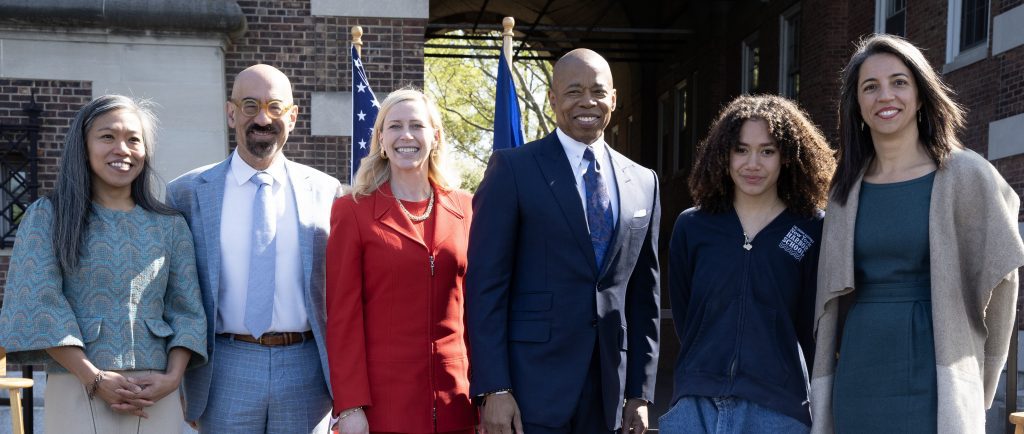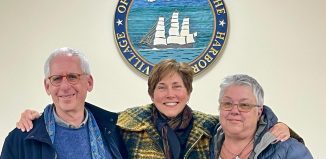SBU will develop $700M climate center on Governors Island

With a vision to turn parts of Governors Island into a world-class center that blends into the surrounding greenery, Stony Brook University won the highly competitive process to create a climate solutions center.
New York City Mayor Eric Adams (D) and the Trust for Governors Island earlier this week named Stony Brook the lead in teaming up with other universities, nonprofits and businesses to create a $700 million facility that will start construction in 2025 and open in 2028.
Backed by a $100 million donation from the Simons Foundation, a $50 million gift from Bloomberg Philanthropies and $150 million from the City of New York, Stony Brook will create a unique 400,000 square-foot facility.
The center will house research laboratories and host community discussions, train 6,000 people to work in green energy jobs per year, provide educational opportunities and search for climate solutions, including those that affect low-income communities of color.
“Climate change is here and the danger is real,” Adams said at a press conference on Governors Island unveiling the winner of the competition. “I am proud to announce that we have selected a team led by Stony Brook University to deliver the New York Climate Exchange.”
Adams suggested the Stony Brook team, which includes local partners like Pace University, New York University and the City University of New York, will protect the city’s air and water.
The Trust for Governors Island also anticipates the site, which will include a “semester abroad” on-site, fellowships and internship programs, will host scientific symposiums that can bring together leaders in a range of fields.
In an email, Simons Foundation President David Spergel hopes the center will “nucleate new business that generates jobs in the region, invest in new technologies and advance solutions.”
The foundation is helping to recruit other benefactors to meet the financial needs for the site both by the example of its commitment and through personal interactions, Spergel said.
Stony Brook, meanwhile, which has a deep pool of researchers at the School of Marine and Atmospheric Sciences investigating climate-related issues, doesn’t plan to wait until the buildings are refurbished and constructed to start the conceptual and educational work.
During phase zero, the university will “work with our partners immediately” on developing programs for kindergarten through grade 12 outreach, on scaling up green workforce development and on developing collaborative research projects across institutions, SBU President Maurie McInnis said in a town hall discussion with the campus community.

Practice what it preaches
In addition to providing space that will generate and test out ideas for solutions to climate change, the New York Climate Exchange buildings will minimize the carbon footprint.
There will be 230,000 square feet of new space and 170,000 square feet of refurbished existing structures. The plans, which were created by Skidmore, Owings & Merrill, involve creating the biggest mass-timber building in New York City. As an alternative to concrete and steel, mass timber has a lower carbon footprint and is lighter.
Mass timber uses “less material and in a more efficient way,” said Keith O’Connor, principal at SOM, who runs the city design practice in New York and Washington, D.C., in an interview.
SOM designed the tops of the buildings with 142,000 square feet of solar cells, which will generate more than enough power for the site, enabling the center to provide all of its electricity needs and to send some energy to the city.
“We wanted to work really hard to avoid having a field of solar panels sitting off to the side” or sticking solar panels on each roof, O’Connor said. Instead, the solar panels, which will be at slightly different angles from each other, track the topography of the structures without creating a glaring field of reflected light.
Guests who arrive at Governors Island will notice a solar canopy that is “front and center,” O’Connor said. “It’s about a message for everyone who is visiting — it says that energy generation is critical.”
SOM wanted to find a way to create a warm and welcoming aesthetic that provides energy, O’Connor added.
All of the nondrinking water will come from rainwater and treated wastewater.
The site anticipates diverting 95% of waste from landfills, making it one of the first in the country to achieve true zero-waste certification.
“The concept of the physical structure is astonishing,” David Manning, director of Stakeholder Relations at Brookhaven National Laboratory, which will serve as an adviser on the center, said in an interview. “You want to attract the best and the brightest. You do that with programming. It doesn’t hurt that [the design and the facilities] are also cool.”
An aerial rendering of the island after construction, which will also include 4.5 acres of new open space, looks more like a park than a typical research station.
Governors Island, which hosts about a million visitors each year who arrive on ferries that run every half hour, plans to double the ferry service, with trips traveling every 15 minutes during the day starting next year. Also in 2024, the city will start using a hybrid electric ferry to reduce emissions.
Considerable collaborative support
McInnis expressed her gratitude to the team at Stony Brook and to her partners for putting together the winning proposal.
McInnis suggested that the university’s commitment to studying, understanding and mitigating climate change, coupled with national and international collaborations, would unite numerous strengths in one place.
“We knew we had the right team to lead this effort,” said McInnis at the announcement on Governors Island. “We also knew we needed a diverse set of partners” in areas including environmental justice, in the business sector and in philanthropic communities.
Other partners include Georgia Tech, University of Washington, Duke University, Rochester Institute of Technology and University of Oxford, England.
BNL’s Manning appreciated the opportunity to attend the kickoff of the project on Governors Island.
Near the tip of Manhattan amid a “stunning blue sky,” the gathering was the “perfect setting” to announce and create solutions that were “this future focused,” Manning said.






